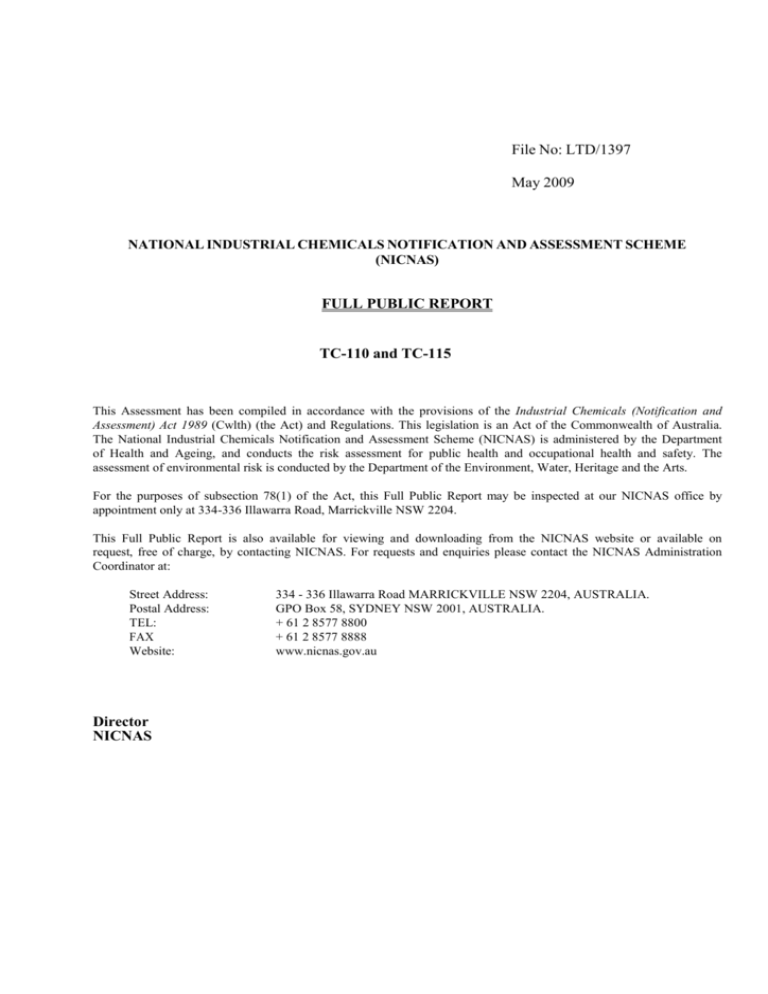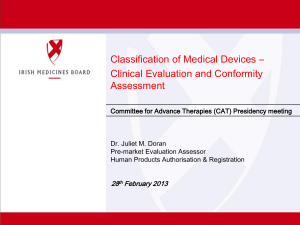LTD/1397
advertisement

File No: LTD/1397 May 2009 NATIONAL INDUSTRIAL CHEMICALS NOTIFICATION AND ASSESSMENT SCHEME (NICNAS) FULL PUBLIC REPORT TC-110 and TC-115 This Assessment has been compiled in accordance with the provisions of the Industrial Chemicals (Notification and Assessment) Act 1989 (Cwlth) (the Act) and Regulations. This legislation is an Act of the Commonwealth of Australia. The National Industrial Chemicals Notification and Assessment Scheme (NICNAS) is administered by the Department of Health and Ageing, and conducts the risk assessment for public health and occupational health and safety. The assessment of environmental risk is conducted by the Department of the Environment, Water, Heritage and the Arts. For the purposes of subsection 78(1) of the Act, this Full Public Report may be inspected at our NICNAS office by appointment only at 334-336 Illawarra Road, Marrickville NSW 2204. This Full Public Report is also available for viewing and downloading from the NICNAS website or available on request, free of charge, by contacting NICNAS. For requests and enquiries please contact the NICNAS Administration Coordinator at: Street Address: Postal Address: TEL: FAX Website: Director NICNAS 334 - 336 Illawarra Road MARRICKVILLE NSW 2204, AUSTRALIA. GPO Box 58, SYDNEY NSW 2001, AUSTRALIA. + 61 2 8577 8800 + 61 2 8577 8888 www.nicnas.gov.au TABLE OF CONTENTS FULL PUBLIC REPORT .............................................................................................................................................. 3 1. APPLICANT AND NOTIFICATION DETAILS .................................................................................... 3 2. IDENTITY OF CHEMICAL ................................................................................................................... 3 3. COMPOSITION....................................................................................................................................... 3 4. PHYSICAL AND CHEMICAL PROPERTIES ....................................................................................... 3 5. INTRODUCTION AND USE INFORMATION. .................................................................................... 4 6. HUMAN HEALTH IMPLICATIONS ..................................................................................................... 5 7. ENVIRONMENTAL IMPLICATIONS................................................................................................... 6 8. CONCLUSIONS AND REGULATORY OBLIGATIONS ..................................................................... 7 BIBLIOGRAPHY ........................................................................................................................................................ 9 Created on 5/8/2009 2:14:00 PM Last Saved 5/8/2009 2:14:00 PM May 2009 NICNAS FULL PUBLIC REPORT TC-110 and TC-115 1. APPLICANT AND NOTIFICATION DETAILS APPLICANT(S) Konica Minolta Business Solutions Australia Pty Ltd (ABN 50 001 065 096) 22 Giffnock Avenue North Ryde, NSW 2113 NOTIFICATION CATEGORY Limited-small volume: Chemical other than polymer (1 tonne or less per year). EXEMPT INFORMATION (SECTION 75 OF THE ACT) Data items and details claimed exempt from publication: chemical name, CAS number, molecular formula, structural formula, molecular weight, spectral data and identity of manufacturer. VARIATION OF DATA REQUIREMENTS (SECTION 24 OF THE ACT) Variation to the schedule of data requirements is claimed as follows: vapour pressure, hydrolysis as a function of pH, partition coefficient, absorption/desorption, dissociation constant, flash point, flammability limits and autoignition temperature. PREVIOUS NOTIFICATION IN AUSTRALIA BY APPLICANT(S) None NOTIFICATION IN OTHER COUNTRIES None 2. IDENTITY OF CHEMICAL MARKETING NAME(S) TC-110 and TC-115 MOLECULAR WEIGHT < 500 Da ANALYTICAL DATA Reference X-ray powder diffraction spectra were provided. 3. COMPOSITION DEGREE OF PURITY 100% HAZARDOUS IMPURITIES/RESIDUAL MONOMERS None NON HAZARDOUS IMPURITIES/RESIDUAL MONOMERS (>1% by weight) ADDITIVES/ADJUVANTS 4. None None PHYSICAL AND CHEMICAL PROPERTIES APPEARANCE AT 20ºC AND 101.3 kPa: White powder FULL PUBLIC REPORT: LTD/1397 Page 3 of 9 May 2009 NICNAS Property Melting Point/Freezing Point Density Vapour Pressure Value Approximately 1975oC 3980 kg/m3 Not expected to be volatile Water Solubility Hydrolysis as a Function of pH Insoluble Not determined Partition Coefficient (n-octanol/water) Not determined Adsorption/Desorption Not determined Dissociation Constant Not determined Particle Size Flash Point In the several tens of nm with the agglomerated particle size being approximately 300 nm. Not determined Flammability Not determined Autoignition Temperature Not determined Explosive Properties Not expected to be explosive Data Source/Justification MSDS MSDS Based on the chemical structure and the high melting point. MSDS Test not conducted due to the insolubility in water. The notified chemical contains no hydrolysable functional groups. Test not conducted due to the insolubility in water. The notified chemical is not expected to be distributed to the organic phase of noctanol based on it being an inorganic salt. Test not conducted due to the insolubility in water. The notified chemical is expected to have a low affinity for organic matter in soils based on it being an inorganic salt. Test not conducted due to the insolubility in water. The notified chemical is expected to be ionised throughout the environmental pH range of 4 – 9 based on it being an inorganic salt. Provided by notifier, test report not sighted. Not conducted due to the notified chemical being a solid with a very high melting point. Not expected to be flammable under normal conditions of use. Not expected to autoignite under normal conditions of use. The structural formula contains no explosophores. DISCUSSION OF PROPERTIES Reactivity Stable under normal conditions of use. 5. INTRODUCTION AND USE INFORMATION MODE OF INTRODUCTION OF NOTIFIED CHEMICAL OVER NEXT 5 YEARS The notified chemical will not be manufactured in Australia. It will be imported as a component of the toner (1%) in sealed toner cartridges. The toner has an average particle size of approximately 6.5 μm and therefore the notified chemical is not introduced as a nanoparticle. MAXIMUM INTRODUCTION VOLUME OF NOTIFIED CHEMICAL (100%) OVER NEXT 5 YEARS Year Tonnes 1 0.2 2 0.3 3 0.4 4 0.5 5 0.6 PORT OF ENTRY Throughout Australia. FULL PUBLIC REPORT: LTD/1397 Page 4 of 9 May 2009 NICNAS TRANSPORTATION AND PACKAGING The sealed toner cartridges will primarily be transported throughout Australia by road. USE The notified chemical is a component in toner cartridges at a concentration of 1%. OPERATION DESCRIPTION The notified chemical will not be manufactured, reformulated or repackaged in Australia. Sealed cartridges containing the notified chemical will be handled by service technicians, office workers or the public, who will replace spent cartridges in the photocopiers and printers as necessary. The cartridges containing the notified chemical will not be refilled within Australia. 6. 6.1 HUMAN HEALTH IMPLICATIONS Exposure assessment 6.1.1 Occupational exposure Exposure to workers during transport and storage is possible only in the event of an accident where the containers are damaged. Dermal or inhalation exposure of workers to the notified chemical could occur during replacement of cartridges in printers and photocopiers. However, this will be minimised as procedures for correct replacement of cartridges are contained in the manufacturer’s literature and the notified chemical is present at low concentrations (1%) in the toner. Once printed onto the paper, the notified chemical is expected to remain bound to the paper with negligible transfer on dermal contact. 6.1.2. Public exposure Similar to office workers, the public may intermittently be exposed to the notified chemical when replacing spent cartridges and during use of printers. However, as it is expected that the public will be using the printer less frequently than workers, exposure is also expected to be lower. 6.2. Human health effects assessment No toxicological data were submitted for the notified chemical. There are however some acute toxicity studies on the notified chemical present in the literature (RTECS). Toxicokinetics, metabolism and distribution. Based on its lack of solubility in both water and n-octanol, the notified chemical is not expected to be readily absorbed transdermally or from the gastrointestinal tract. The inhalation of respirable particles containing the notified chemical is possible given the average particle size of the toner is 6.5 µm. Acute toxicity. The notified chemical is reported to have an LD50 of 5,300 mg/kg bw (intraperitoneal) and an LD50 of > 12,000 mg/kg bw (oral) (RTECS). Based on this information for the notified chemical it is considered to be of low acute toxicity via the oral route. Mutagenicity The MSDS of the notified chemical indicated that it showed a negative result for germ cell mutagenicity. Health hazard classification Based on the information provided the notified chemical is not classified as hazardous under the Approved Criteria for Classifying Hazardous Substances (NOHSC, 2004). 6.3. Human health risk characterisation 6.3.1. Occupational health and safety Based on the available information, the notified chemical is considered to have low acute oral toxicity and to be non mutagenic to bacteria. FULL PUBLIC REPORT: LTD/1397 Page 5 of 9 May 2009 NICNAS Some particles of the notified chemical are in the nanometre (< 100 nm) size scale however when introduced into Australia the notified chemical will be a component of toner particles with an average size of 6.5 μm. The health effects from exposure to nanoparticles of the notified chemical are not known as there are no chronic inhalation toxicity studies conducted on the notified chemical. Due to the notified chemical and the toner particles being of a nonfibrogenic nature, fibrosis and physical damage to the lungs is not expected (Patty’s Ind Hyg Tox, 1991). Repeated inhalation of airborne dusts of the notified chemical, or inhalation of high airborne concentrations, may present some risk of lung overloading effects. However, given the low concentration of the notified chemical in the product and the minimal release expected from the toner cartridges, high airborne concentrations of the notified chemical are unlikely to occur. The Australian recommended exposure standard for nuisance dust is 10 mg/m3 [NOHSC 3008:(1995)], but the American Conference of Governmental Industrial Hygienists (ACGIH) recommends an exposure limit of 3 mg/m3 for “respirable (insoluble) particulates (not otherwise regulated)” (ACGIH, 2006). Due to the low concentration of the notified chemical in the imported toner cartridges and the expected low exposure it is not considered to pose an unacceptable risk to the health of workers. 6.3.2. Public health Given the limited potential for public exposure to the notified chemical when used in toner cartridges, and its lack of solubility or identified health hazard, the introduction of the notified chemical is not expected to pose an unacceptable risk to public health. 7. ENVIRONMENTAL IMPLICATIONS 7.1 Environmental Exposure & Fate Assessment 7.1.1 Environmental Exposure RELEASE OF CHEMICAL AT SITE The notified chemical will be imported into Australia for direct use. Neither manufacture nor reformulation will occur in Australia. Therefore, no significant release of the notified chemical is expected. RELEASE OF CHEMICAL FROM USE Significant release of the notified chemical from use is not expected. Empty cartridges will be disposed of to landfill. RELEASE OF CHEMICAL FROM DISPOSAL Residues in the empty cartridges will be disposed of to landfill together with the containers. The majority of the notified chemical contained in the toner product will be applied to paper via printing or copying processes. Based on a commonly accepted assumption, about 50% of the printed paper will be sent to landfill at the end of the useful life, and the rest (50%) will be recycled for reuse. The associated notified chemical will share the fate of the substrate. During the recycling, the notified chemical will be precipitated out into the sediment after fibre detachment process, and be finally sent to landfill. 7.1.2 Environmental fate No environmental fate data were submitted. The notified chemical is not expected to be bio-available to the aquatic life due to both its insolubility in water and the low exposure to the environment expected from its reported use pattern. 7.1.3 Predicted Environmental Concentration (PEC) The calculation of PEC is not necessary based on its proposed low import volume and reported use pattern. FULL PUBLIC REPORT: LTD/1397 Page 6 of 9 May 2009 7.2 NICNAS Environmental effects assessment No ecotoxicity data were submitted. The notified chemical is not expected to have any adverse effect on the aquatic environment based on its proposed low import volume and reported use pattern. 7.2.1 Predicted No-Effect Concentration The PNEC has not been calculated since no significant release of the notified chemical to the environment is expected based on the reported use pattern. 7.3 Environmental risk assessment The Risk Quotient (PEC/PNEC) has not been calculated since no significant release of the notified chemical to the environment is expected based on the reported use pattern. The notified chemical is not considered to pose an unacceptable risk to the aquatic ecosystem based on its reported use pattern. 8. CONCLUSIONS AND REGULATORY OBLIGATIONS Hazard classification Based on the information provided the notified chemical is not classified as hazardous under the Approved Criteria for Classifying Hazardous Substances [NOHSC:1008(2004)]. Human health risk assessment Under the conditions of the occupational settings described, the notified chemical is not considered to pose an unacceptable risk to the health of workers. When used in the proposed manner, the notified chemical is not considered to pose an unacceptable risk to public health. Environmental risk assessment On the basis of the reported use pattern, the notified chemical is not considered to pose a risk to the environment. Recommendations CONTROL MEASURES Occupational Health and Safety Employers should implement the following safe work practices to minimise occupational exposure during handling of toner cartridges containing the notified chemical: Avoid the formation of airborne dusts A copy of the MSDS should be easily accessible to employees. If products and mixtures containing the notified chemical are classified as hazardous to health in accordance with the Approved Criteria for Classifying Hazardous Substances [NOHSC:1008(2004)] workplace practices and control procedures consistent with provisions of State and Territory hazardous substances legislation must be in operation. Environment Do not allow material or contaminated packaging to enter drains, sewers, or water courses. Disposal FULL PUBLIC REPORT: LTD/1397 Page 7 of 9 May 2009 NICNAS The notified chemical should be disposed of to landfill. Emergency procedures Spills or accidental release of the notified chemical should be handled by physical containment, collection and subsequent safe disposal. Regulatory Obligations Secondary Notification This risk assessment is based on the information available at the time of notification. The Director may call for the reassessment of the chemical under secondary notification provisions based on changes in certain circumstances. Under Section 64 of the Industrial Chemicals (Notification and Assessment) Act (1989) the notifier, as well as any other importer or manufacturer of the notified chemical, have post-assessment regulatory obligations to notify NICNAS when any of these circumstances change. These obligations apply even when the notified chemical is listed on the Australian Inventory of Chemical Substances (AICS). Therefore, the Director of NICNAS must be notified in writing within 28 days by the notifier, other importer or manufacturer: (1) Under Section 64(1) of the Act; if the importation volume exceeds one tonne per annum notified chemical; the notified chemical is introduced with a particle size of 100 nm or less. or (2) Under Section 64(2) of the Act; if the function or use of the chemical has changed from a component in toner cartridges at a concentration of 1%, or is likely to change significantly; the amount of chemical being introduced has increased, or is likely to increase, significantly; the chemical has begun to be manufactured in Australia; additional information has become available to the person as to an adverse effect of the chemical on occupational health and safety, public health, or the environment. The Director will then decide whether a reassessment (i.e. a secondary notification and assessment) is required. Material Safety Data Sheet The MSDS of the notified chemical and products containing the notified chemical provided by the notifier were reviewed by NICNAS. The accuracy of the information on the MSDS remains the responsibility of the applicant. FULL PUBLIC REPORT: LTD/1397 Page 8 of 9 May 2009 NICNAS BIBLIOGRAPHY ACGIH (2006) Particulates (Insoluble) Not Otherwise Specified (PNOS). In: TLVs and BEIs. American Conference of Governmental Industrial Hygienists (ACGIH), p9. FORS (Federal Office of Road Safety) (1998) Australian Code for the Transport of Dangerous Goods by Road and Rail (ADG code), 6th Edition, Canberra, Australian Government Publishing Service NOHSC (1994) National Code of Practice for the Labelling of Workplace Substances [NOHSC:2012(1994)]. National Occupational Health and Safety Commission, Canberra, Australian Government Publishing Service. NOHSC (1995) Exposure Standards for Atmospheric Contaminants in the Occupational Environment [NOHSC:3008 (1995)]. National Occupational Health and Safety Commission, Canberra, Australian Government Publishing Service. NOHSC (2003) National Code of Practice for the Preparation of Material Safety Data Sheets, 2nd edition [NOHSC:2011(2003)]. National Occupational Health and Safety Commission, Canberra, Australian Government Publishing Service. NOHSC (2004) Approved Criteria for Classifying Hazardous Substances, 3rd edition [NOHSC:1008(2004)]. National Occupational Health and Safety Commission, Canberra, AusInfo. Patty's Industrial Hygiene and Toxicology (1991) 4th Edition, Volume IA: 289 – 327. RTECS (Registry of Toxic Effects of Chemical Substances). Compiled by the National Institute for Occupational Safety and Health (NIOSH) of the U.S. Department of Health and Human Services. Accessed 02 January 2009. United Nations (2003) Globally Harmonised System of Classification and Labelling of Chemicals (GHS). United Nations Economic Commission for Europe (UN/ECE), New York and Geneva. FULL PUBLIC REPORT: LTD/1397 Page 9 of 9





